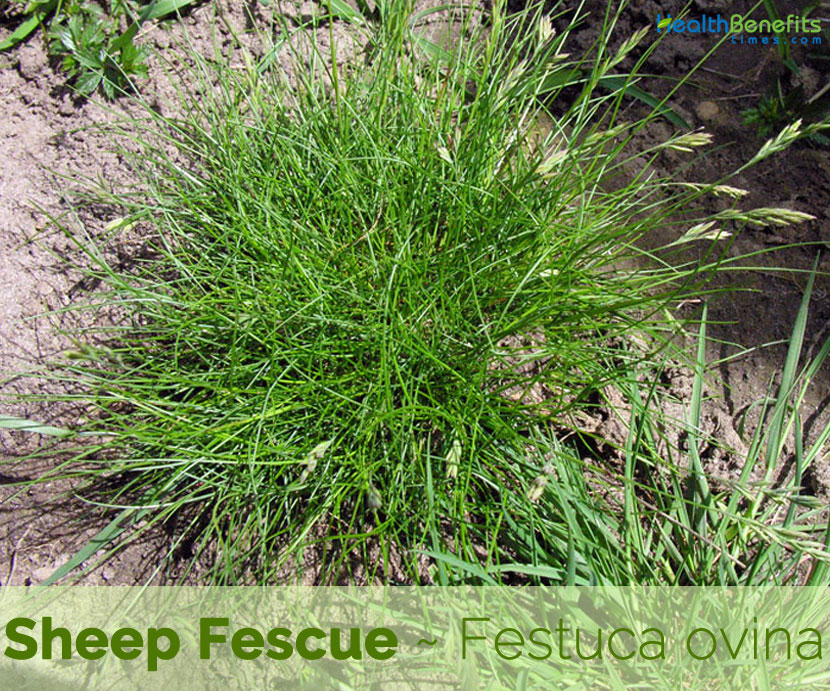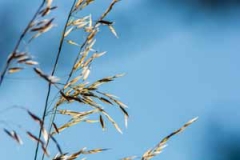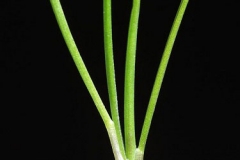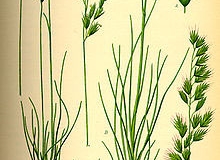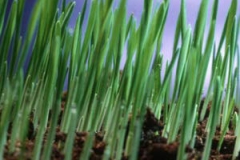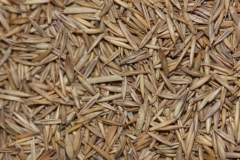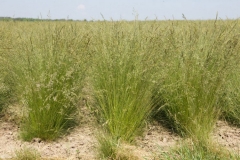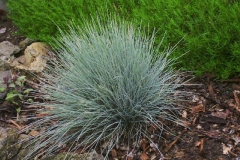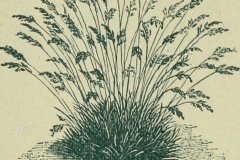Plant Description
Sheep fescue is a low-growing stress tolerant, perennial cool season turf grass that grows about 40 inches. The plant is found growing in mesic open hillsides, meadows, or open woodlands, exposed bench lands, hillsides and ridges, parks, meadows, forestlands, and open ponderosa and lodge pole pine stands, lowland calcareous grasslands, upland heaths, moors, mountain slopes, rock ledges, and sea-cliffs. It often grows on all exposures in a wide variety of soil conditions. It is often found in dry, well-drained, sandy, gravelly, or rocky soils; however is occasionally found on loamy sand soils, and on shallow, dry, gravelly soils. It is sometimes used as a drought-tolerant lawn grass. It has excellent winter hardiness and develops a large root mass making this a long-lived variety. Sheep Fescue differs from hard fescue in that it is shorter (5-10 cm or 2-4 inches), slightly more drought tolerant, and has a blue-green color.
Leaves
Leaves are mainly basal, numerous, and rolled. They are very slender, rough to the touch on the margins, and 2-5 inches long. They are less than half the length of the stem; the stem leaves are few and very short. The sheaths are open, auricles are absent, and the ligule is membranous. The leaves are blue-green-gray in color which helps identify this species from other similar grasses.
Flowers
Panicle is approximately 15 cm long with 1 side branch at the lower nodes. It is initially upright, and then spread horizontally. Spikelets have long pedicels, usually 5–9 florets which flower from May to June. Glumes are rounded at the top; lemmas are ovate, awn-tipped, and often purple. The flowers are hermaphrodite (have both male and female organs) and are normally pollinated by wind.
Fertile flowers are followed by grain short and plump (mussel-shaped), lemma sharply pointed at the top, mostly awnless, but may also be awn-tipped. Pedicel is 0.5-1 mm long (shorter than that of red fescue), widening towards the top and covered in short hairs.
History
Sheep fescue is a cool season perennial grass native to Europe. Within North America, sheep fescue has been planted in open forests and mountain and foothill slopes from Alaska to North Dakota and south to Arizona and New Mexico. It has also been introduced to many locations in eastern North America.
References:
https://www.itis.gov/servlet/SingleRpt/SingleRpt?search_topic=TSN&search_value=40804#null
https://npgsweb.ars-grin.gov/gringlobal/taxonomydetail.aspx?id=16688
https://pfaf.org/user/Plant.aspx?LatinName=Festuca+ovina
https://plants.usda.gov/core/profile?symbol=FEOV
http://www.theplantlist.org/tpl1.1/record/kew-415853
http://www.eu-nomen.eu/portal/taxon.php?GUID=907B7888-8662-4006-83DD-63B759EEA6E3
https://extension.usu.edu/rangeplants/grasses-and-grasslikes/sheep-fescue
https://gd.eppo.int/taxon/FESOV
https://en.wikipedia.org/wiki/Festuca_ovina
Comments
| Sheep Fescue Quick Facts | |
|---|---|
| Name: | Sheep Fescue |
| Scientific Name: | Festuca ovina |
| Origin | Throughout Europe (with the exception of some Mediterranean areas) and eastwards across much of Asia |
| Shapes | Grain short and plump (mussel-shaped), lemma sharply pointed at the top, mostly awnless, but may also be awn-tipped |
| Name | Sheep fescue |
|---|---|
| Scientific Name | Festuca ovina |
| Native | Throughout Europe (with the exception of some Mediterranean areas) and eastwards across much of Asia |
| Common Names | Common fescue, Sheep fescue, ovina, Blue Fescue |
| Name in Other Languages | Albanian: Bishtpelëza leshtake, bishtpelëza pak e forte Arabic: Fustawkat al’aghnam (فستوكة الأغنام), fustawkat ghanmia (فستوكة غنمية) Bulgarian: Ovcha vlasatka (овча власатка) Catalan: Fanals, festuca duriúscula, festuca ovina Chinese: Yang mao (羊茅) Croatian: Vlasulja ovčja, obična vlasulja Czech: Kostřava ovčí Danish: Fåre-svingle, Stivbladet svingel, Ruig en Zinkschapengras Dutch: Schapegras, Schapen-zwenkgras, Ruig en Zinkschapengras, Genaald schapengras English: Common fescue, Sheep fescue, ovina, Blue Fescue Estonian: Lamba-aruhein Finnish: Lampaannata French: Coquiole, Fétuque des moutons, Fétuque ovine, petit foin, poil de chien, poil de loup Galician: Feisciú caorach Georgian: Tskhvris ts’ivana (ცხვრის წივანა) German: Echter Schwingel, Kleiner Bockbart, Meitschihaar, Schafschwingel, Schaf-Schwingel, Echter Schaf-Schwingel, fétuque des moutons, eigentlicher Schafschwingel, Greek: Festoúka ktinotrofikí (Φεστούκα κτηνοτροφική) Hungarian: Iuhcsenkesz Irish: Féar caorach, Feisciú caorach Italian: Festuca dei montoni, Festuca ovina, Gramigna betaiola, Gramigna fusaiola, gramigna stefaiola, paleo capillare Japanese: Ushi no ke gusa (ウシノケグサ) Korean: Gim ui teol (김의털) Latvian: Aitu auzene Lithuanian: Avinis eraičinas Macedonian: Овчи виук Norwegian Bokmål: Bakkesvingel, sauesvingel Persian: علفبره Polish: Kostrzewa owcza Portuguese: Festuca-ovelha, laborinho Romanian: Păiușul oilor Russian: Ovsianitsa ovech’ia (Овсяница овечья) Serbian: Vijuk obični, obični vijuk (обични вијук), jančarica vlasulja (јанчарица власуља) Slovak: Kostrava ovčia Slovenian: Ovčja bilnica Spanish: Cañuela de oveja, barcea, cañotilla, escobilla, pan de corderos Swedish: Fårsvingel, Lampaannata, Vanlig fårsvingel Turkish: Koyunyumağı Ukrainian: Костриця овеча Welsh: Peiswellt y defaid |
| Plant Growth Habit | Low-growing stress tolerant, perennial cool season turf grass |
| Growing Climates | Mesic open hillsides, meadows, or open woodlands, exposed bench lands, hillsides and ridges, parks, meadows, forestlands, and open ponderosa and lodge pole pine stands, lowland calcareous grasslands, upland heaths, moors, mountain slopes, rock ledges, sea-cliffs |
| Soil | It grows on all exposures in a wide variety of soil conditions. It is often found in dry, well-drained, sandy, gravelly, or rocky soils; however is occasionally found on loamy sand soils, and on shallow, dry, gravelly soils |
| Plant Size | About 40 inches |
| Culms | Culms upright to inclined, usually with 2 nodes. Culm heights range from 15–40–60 cm depending on form |
| Stem | Erect stems, 6-24 inches tall (average is less than 14 inches tall). |
| Leaf | Leaf folded in the bud. Leaf blade needle-like, very slender, impossible to unfurl. Leaf color has many transitions from grey-green to sea-green to blue-green. The ligule is short and lobed at the sides |
| Flowering season | May to June |
| Flower | Panicle approx. 15 cm long with 1 side branch at the lower nodes. Upright initially, then spread horizontally. Spikelets have long pedicels, usually 5–9 florets which flower in April/May. Glumes rounded at the top, lemmas ovate, awn-tipped, and often purple |
| Fruit Shape & Size | Grain short and plump (mussel-shaped), lemma sharply pointed at the top, mostly awnless, but may also be awn-tipped. Pedicel 0.5-1 mm long (shorter than that of red fescue), widening towards the top and covered in short hairs. |
| Propagation | By seed |


